
 TUTORIAL: THE COMMUNICATION PROCESS
TUTORIAL: THE COMMUNICATION PROCESSINTRODUCTION . SYSTEMS . THE ROLE OF COMMUNICATION . HUMAN AND NON-HUMAN COMMUNICATION . THE SHANNON/WEAVER MODEL OF COMMUNICATION . CONTENT AND CODE .
Here are a few of the many examples of the communication process that exist in the world that human beings inhabit.
Clearly then, under the definition of communication that was developed in the previous section of this tutorial, the sender and the receiver of messages can be such as whales, cereal boxes, nerve cells, and computers. This leads to the next insight into the nature of communication.
Of course, as human beings ourselves, we are naturally most interested in human
communication, and in fact the remainder of these tutorials are devoted to exactly
that. But for a moment, take time to consider the wider implication - that
communication is the glue that holds everything together. Here are a few examples.
![]() 9013
9013
1. A school of fish swims lazily through the water beneath the sea. Suddenly, the entire school turns as one and flits off in a new direction.

Surely it is some form of communication that permits the school
to move with such precision. But which? Visual - each fish watching the one
in front? Through a sense of sound? Or of smell? Jeremy Campbell comments on
the biological role of communication
![]() 9023
9023
![]() 9024
9024
![]() 9025
9025
...communication is not confined to radios, telephones, and television channels. It occurs in nature, wherever life exists. The genes are a system for sending chemical messages to the protein factories of the cell, instructing them to make a living organism. The human being is the most complex communications network on earth. - Campbell 1982, 67
Thus, communication is not merely speech among humans. It includes the many different kinds of messages that connect organisms of all kinds. And more than that, communication plays a role in the chemical and electrical systems that constitute the organisms.
2. Electrons orbit the nuclei of three atoms, one an oxygen atom and two of hydrogen. The result is a molecule of "water."

This might be a situation in chemistry, perhaps, or physics, but what could it have to do with communication? In response let us offer the words of Nobel Prize-winning Chemist Ilya Prigogine as he discusses the behavior of certain chemical "clocks" that change color with astounding regularity.
Such a degree of order stemming from the activity of billions of molecules seems incredible, and indeed, if chemical clocks had not been observed, no one would believe that such a process is possible. To change color all at once, molecules must have a way to "communicate." The system has to act as a whole. We will return repeatedly to this key word, communicate, which is of obvious importance in so many fields, from chemistry to neurophysiology. - Prigogine and Strengers 1984, 148
Communication, then, is not merely a characteristic of humans, or indeed of living organisms. It is present at the deepest levels of our material universe.
3. A couple purchases a car and pays for it by writing a check.
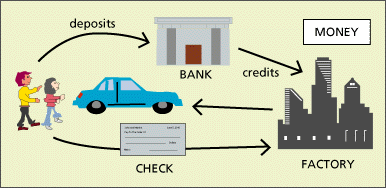
The notion of "money" covers much more than the bills and coins that we might have in our pockets. It includes checks, credit cards, stocks, and the many other devices that we use to record our relative wealth. Furthermore, the value of objects - the car in this example - is not fixed. Value is established in part by negotiation between the buyer and the seller. In fact, "money" seems to be very much a communication process.
4. Finally, consider a situation in which a home computer wakes itself at midnight (the hour at which the rates go down), dials the telephone number of an on-line data service, transmits the proper access codes for the service, downloads a particular data file, signs off, hangs up, saves the file to its disk, and turns itself off.
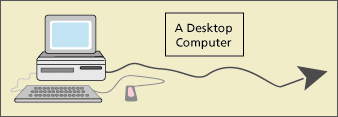
This kind of machine-to-machine communication has become increasingly common since the late-1950s (when computers began to be manufactured and sold in large numbers). Over the same time period, computers have become smaller and smaller, until today some machines - automobiles, for example - contain many computers that "talk" to one another continually to control and manage the machine.
Perhaps one of the most useful of these is the telephone system itself. Each telephone is a computer terminal, and when we dial a number, we send a program to the central phone computer asking it to locate and "ring" a terminal somewhere in the system.
Interestingly, it was the study of telephone transmissions that led to the
development of one of the most widely used models of communication. That model is described in the next section.
![]() 9019
9019
As was said earlier, communication might be thought of as the glue that holds a system together. Communication occurs when one part of the system becomes a transmitter and creates or produces a relationship, called the signal, that travels through space and time to make contact with a second part part of the system, the receiver. These terms are taken from the model of communication that was first introduced by Claude Shannon and Warren Weaver in the late 1940s. The next diagram shows a simple version of the model.
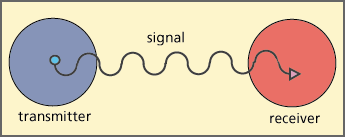
When communication is considered from this point-of-view, any of the various parts of the model may become the focus of study.
These and other questions lead to additional insights into the nature of the communication process.
Clearly, the signal is generated by the transmitter and "noticed" by the receiver, therefore, it must be something physical. Further thought suggests that the signal represents a pattern, or a disturbance, in some substance that forms part of the environment of both transmitter and receiver. The transmitter and receiver are immersed in this substance, which is usually called the medium of communication. The transmitter creates a signal by shaping, changing or disturbing the medium, and the receiver notices the signal by recognizing these changes.
For example
When communication is observed, it is often the case that the signal captured by the receiver is not identical to the signal generated by the transmitter. Sometimes, and somehow, the signal changes as it travels from one to the other. This behavior is explained by noticing that there are ways that the signal might be interfered with as it travels through the medium. The Shannon/Weaver Model illustrates this by adding a term called noise.
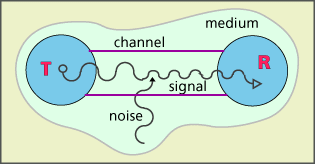
And, in order to emphasize path of the signal, this more complex version of the model also specifies that a certain part of the medium, called the channel, directly connects the transmitter and receiver. In a perfect communication process, the signal would travel along the channel with no interference at all, even though other signals might be moving through the same medium outside of the channel. In the real world, however, most signals are subject to varying amounts of noise.
Here are some examples of how signals flow from transmitter to receiver via well-defined channels, and of how noise sometimes gets into the flow.
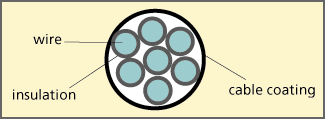 wire in the bundle is a channel, capable of carrying one signal. The bundles of wire group these channels together so that many signals may travel in the same direction. The cable is insulated to prevent noise, however, you may be talking to someone one day when a lightening flash from a nearby thunderstorm generates an electrical charge that interferes with the signal and adds static, or noise, to your phone call.
wire in the bundle is a channel, capable of carrying one signal. The bundles of wire group these channels together so that many signals may travel in the same direction. The cable is insulated to prevent noise, however, you may be talking to someone one day when a lightening flash from a nearby thunderstorm generates an electrical charge that interferes with the signal and adds static, or noise, to your phone call.